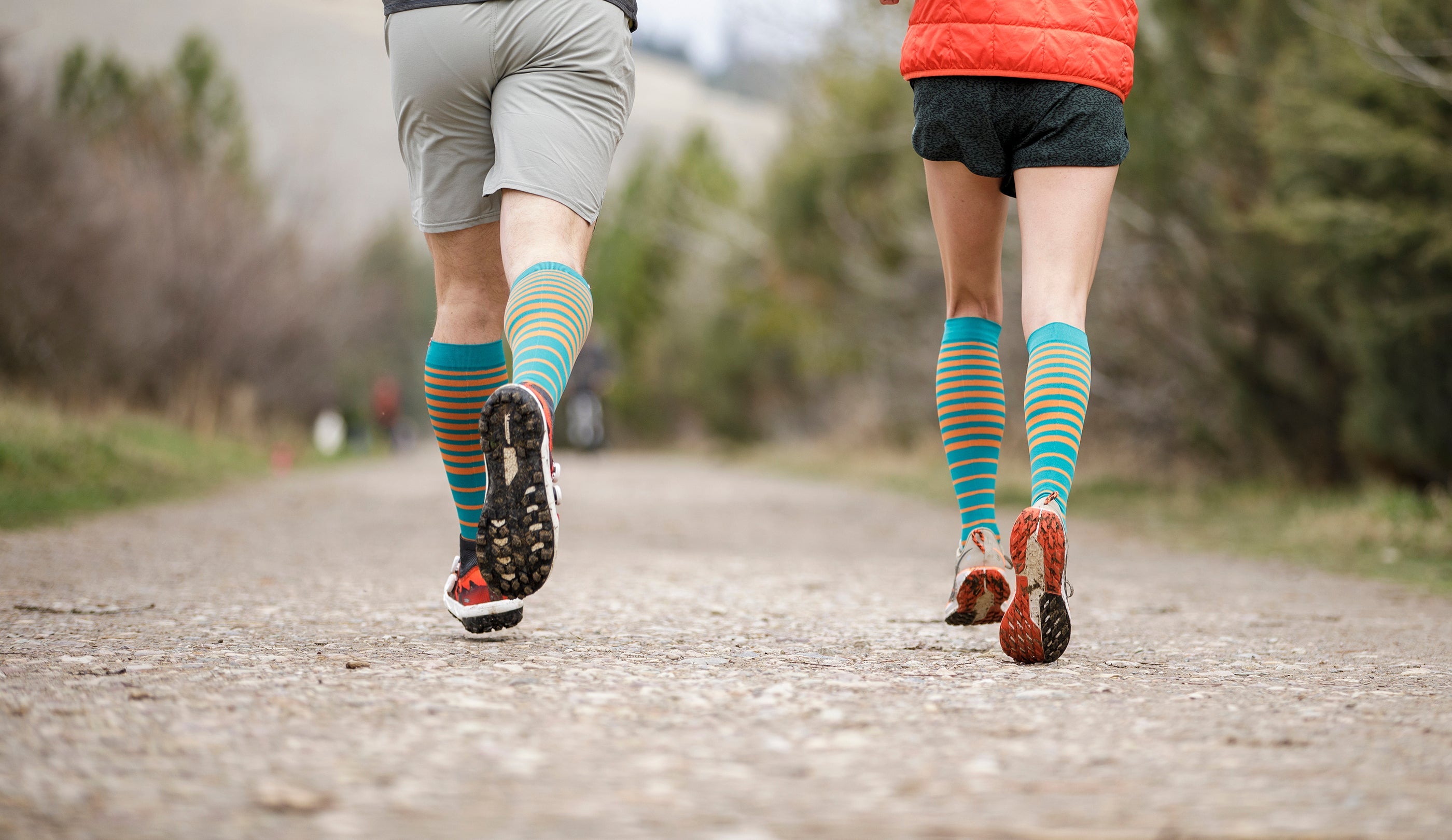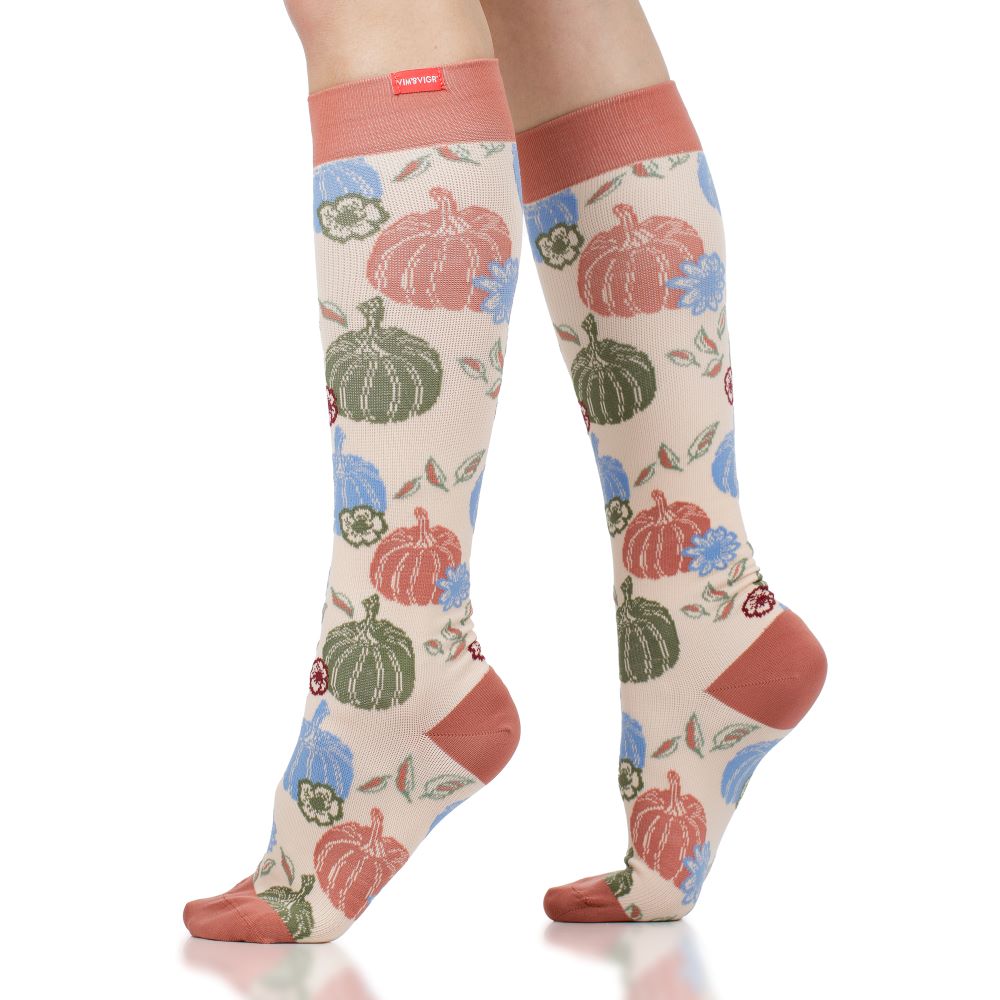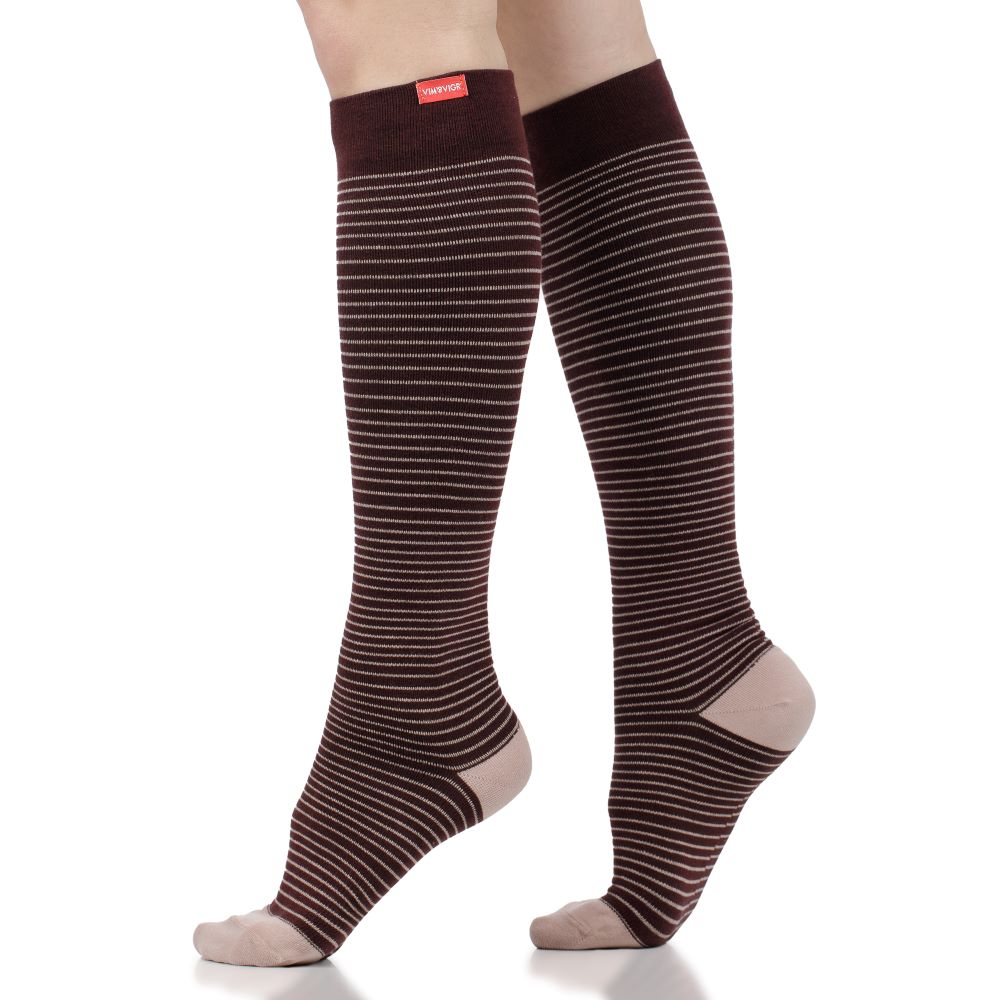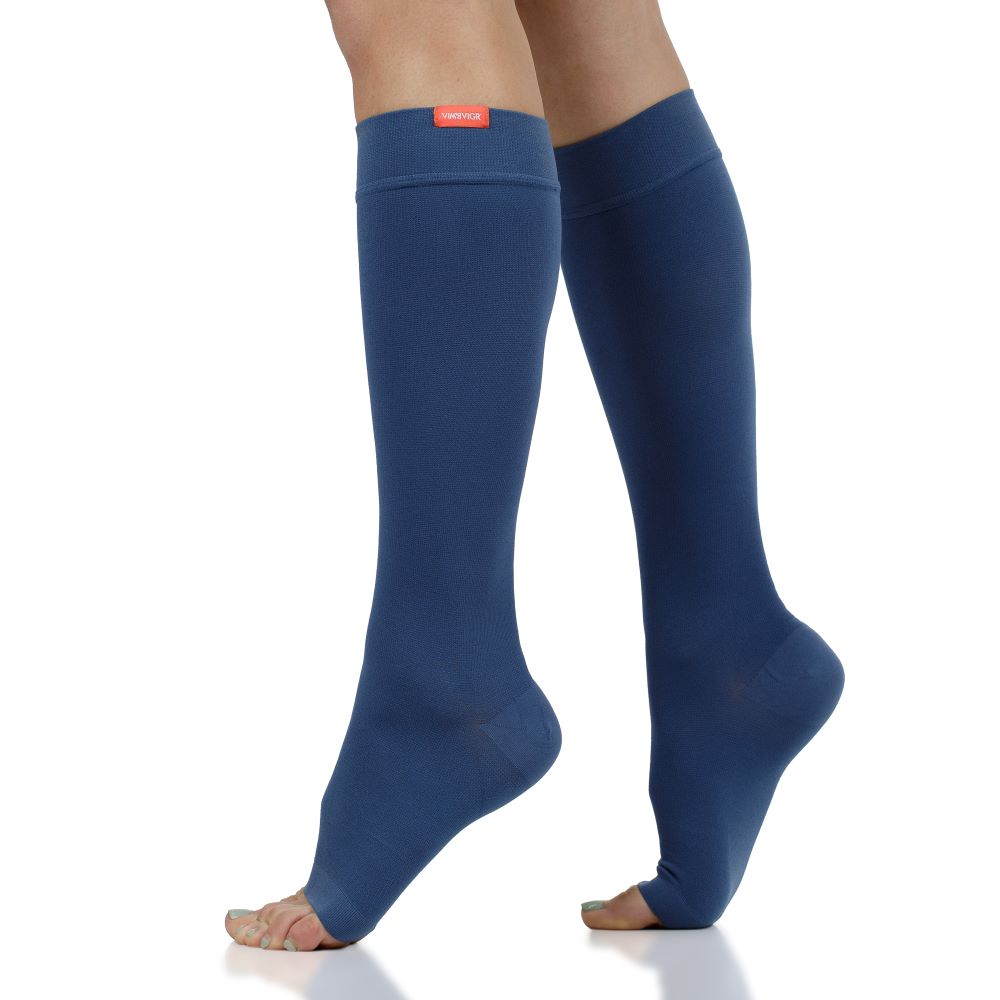The Benefits of Compression Socks for Sciatica + How They Help
Sciatica affects around 10% to 40% of the population over 40 years of age. It’s a massive discomfort, causing lower back pain and even inability to move, along one side of the body, along with leg pain and numbness. However, there are ways to address these issues, and compression socks play their part.
How do compression socks help with sciatica and what are their benefits? Thanks to the gentle pressure applied to your lower legs, compression socks support the muscles and joints, improving stability when you’re in pain or feeling weakened by the nerve pain. They boost blood flow, reducing inflammation and pain in the affected area. And they can prevent other unwanted side effects, such as swelling, discomfort, blood clots, etc.
Read on to find out more about the role of compression socks against symptoms of sciatica.
Do Compression Socks Help with Sciatica?
When you suffer from sciatica (pain caused by the sciatic nerve along its pathway), the pain can travel down the entire leg to your ankle. Compression clothing can address this. Thanks to the gentle pressure that compression socks apply to the lower legs, sciatica patients can get pain relief and a soothing, revitalizing sensation.

Moreover, compression socks improve nerve sensitivity for patients suffering from nerve damage and neuropathy. They help reduce swelling and improve blood circulation. This reduces symptoms like numbness and tingling legs and feet. Finally, as they provide additional support for joints and muscles, compression socks can help sciatica patients to feel more secure and protected when exercising (which is recommended to fight sciatic pain).
Of course, compression is one of many tools to use against sciatica, in agreement with your doctor, who will most likely recommend physical therapy, specific painkillers where needed, and gentle exercise, too.
Understanding Sciatica
To understand how compression socks can help with pain from sciatica, let’s first see how this condition impacts everyday life, particularly when it comes to pain. It’s all linked to the sciatic nerve - which runs from the lower back down to the feet.
If something compresses the sciatic nerve or puts pressure on it, this leads to inflammation and subsequent nerve pain, which can occur throughout the hips, buttocks, and legs. Sometimes, the affected leg can also go numb. Usually, sciatica starts because of a herniated disk or an overgrowth of bone, but it can also set in from the odd impingement on the sciatic nerve. Diseases like diabetes can cause nerve damage leading to sciatica. More rarely, a tumor could also put pressure on the sciatic nerve.
So, how do you know if you have sciatica? Here are the key symptoms:
- You can get pain anywhere on the nerve path - from the lower back to the leg, to lower legs or feet;
- Pain ranges from mild aches to sharp, or sometimes feels like a jolt;
- Sneezing or coughing can make it worse, as well as sitting for a long time;
- Sometimes, the leg goes numb, tingly, or feels weak - and you could experience a combination of symptoms where part of the leg feels numb and part of it is in pain;
- Sciatica usually affects one side of the body only.
How Do Compression Socks Work?
Compression socks are designed to apply gentle pressure to the lower limbs, stimulating blood flow and providing a massage-like feeling. Thanks to the compression, patients wearing them avoid the formation of blood clots and deep vein thrombosis - frequent problems when you suffer with bad peripheral circulation.

Graduated compression stockings and socks are tighter at the ankle, with pressure gradually being released as you move up towards the knee. This stimulates the blood circulation up from the lower body towards the heart. Good blood flow throughout the body then leads to better energy levels, more vitality, and a general feeling of wellbeing.
Compression socks also support the limbs, providing an added help to recovery from injuries like shin splints or Achilles’ tendonitis. The added tightness around the shins and calf muscles can feel very beneficial to athletes, but also to those spending all day on their feet or to long-distance travelers.
How Do Compression Socks Help with Sciatica?
So, does compression help sciatica patients? Here’s how compression socks actually make a difference to those suffering from this condition in particular.
Improved Blood Flow
Good blood circulation is the cornerstone of a well-functioning body. Boosting blood flow helps reduce inflammation and pain, bringing down swelling and discomfort which can be caused by a sciatica flare-up. Graduated compression socks support blood flow going back up to the heart from the lower legs, avoiding swelling and edema. This reduces the risk of pain and discomfort, especially for those who sit all day at work.
Alleviation of Pain and Discomfort
Swelling and pain caused by sciatica can be debilitating. However, wearing compression socks that massage the legs and keep blood flowing through the body can reduce this. They apply pressure throughout the lower legs, which feels relaxing and energizing at the same time.
Reduction of Leg Swelling
Since wearing compression socks promotes better blood circulation, your legs will swell less in them. This is why compression garments are often prescribed to those suffering from edema, among other medical conditions. If your leg is swelling from sciatica, wearing compression socks will improve your wellbeing on both sides of the body.
Promotion of Proper Posture and Alignment
A final key benefit of wearing compression socks when you suffer from sciatica is the support they provide to the legs. Thanks to their tight grip on the ankle and lower leg muscles, compression socks reduce muscle vibrations and support weakened joints and ligaments. They are good for recovering from injuries such as shin splints, Achilles tendonitis, and more. For sciatica patients, they also offer an added level of support to the ankle when you start exercising or simply walking again. Instead of feeling weak or unstable, graduated compression socks can boost your confidence and help you walk more safely.
How to Choose Compression Socks for Sciatica
In order to get the full benefits of compression therapy, the socks you purchase must fit well. Moreover, you need to consider the design of your socks, the material, and the compression level. Here’s a quick guide for getting the best pair for you.
Selecting the Right Compression Level
Depending on your symptoms and how familiar you are with compression garments, you’ll need to consider how tight you’re prepared for them to fit. Compression socks generally come in three levels:
- 15-20 mmHg - moderate compression for everyday wear, suitable for casual wearers, athletes, travelers, etc.;
- 20-30 mmHg - firmer compression which is normally recommended for those suffering with edema, DVT, pre and post surgery, etc.;
- 30-40 mmHg - medical grade socks that can only be bought with a doctor’s prescription.
For first-time wearers, starting with a pair of moderate compression socks is the easiest. You can then adjust as you see fit, once you’re used to them. Alternatively, discuss with a medical professional to see what they recommend based on your diagnosis.
Proper Sizing and Fit
It is imperative that your compression socks for sciatica fit you perfectly. They should be tight on the legs throughout, applying pressure, but not feeling uncomfortable. They should certainly not be cutting off your circulation or causing bruising, tingling, or numbness.
To get the right fit, measure your calf circumference first. Then, use the sizing guide provided here to match it against our sizes. Remember to wear in your socks, starting with shorter wear times, and gradually increasing the time you keep them on as you get more used to them.
Material
Compression socks may help relieve some of your sciatic pain, but you don’t want them getting too sweaty or feeling itchy and uncomfortable. This is why it’s important to choose the right material for them, depending on the weather conditions and what you’re planning to do while wearing your socks.
For all-day wear, regardless of the weather, opt for a pair of cotton compression socks. They come in lots of colors and designs and can liven up an outfit. Soft and comfortable, cotton is good for office wear, for traveling, and more.
If you plan to wear them for running and another sports activity, we advise trying on a pair of nylon socks. These are flexible, sleek, and give you more of a performance feel. Finally, for outdoor adventures and braving the elements, you can’t go wrong with merino wool compression socks. They are breathable and moisture-wicking, but also keep your feet warm in the cold.
We’ve also got some variations on the plain nylon socks you can consider:
- Moisture-wick nylon is for those who prefer a lighter sock, but still want to stay dry while working out or during hot weather;
- Choice nylon socks have no seam in the toe box, which makes them feel a lot more like cotton or merino wool socks - softer, but still slick and lightweight.
Style
Finally, when it comes to the style of compression socks for sciatica, you can consider how they’ll fit with your outfit or interact with other medical conditions or preferences you may have:

- Regular, graduated compression socks are tighter at the ankle and gradually loosen up towards the knee, covering your lower legs and applying a gentle massage to your calf muscles and shins - they are some of the most versatile compression garments for the legs;
- Calf sleeves focus on the calf muscles and cover your from the ankle to below the knee - they provide uniform compression (as opposed to graduated) and can be good when you need to remain barefoot or wish to change your socks more often or wear other types of socks on your feet;
- Open-toe compression socks give the same benefits of regular socks, but leaving the toes out - they can be great with sandals in summer;
- Compression leggings, stockings, or tights cover the whole leg (tights and stockings typically cover the feet, while leggings start at the ankle) for some additional support.
How to Use Compression Socks for Sciatica
Sciatica is a medical condition that usually gets better by itself, in a matter of days or sometimes weeks. If you continue to feel pain and numbness or tingling in the lower back, legs, and feet, for longer, you should check with your doctor. Here’s how to wear compression socks to help relieve some of the symptoms in the meantime.
When to Wear Compression Socks for Sciatica
Compression socks can be worn as a preventative measure, or during an attack of sciatic pain. They’re often prescribed to patients recovering from surgery and who are likely to be bed-ridden or immobile for longer periods of time. They are also good to wear when you’re sitting or standing for long stretches during your work or traveling.
Sitting or lying down when you suffer from sciatica pain is not going to make it better. On the contrary, medical advice is to move around and do some light exercise, such as walking, light stretches, etc. This is when you can wear graduated compression socks to support your joints, make you feel more stable on your feet, and get some pain relief while you get moving.
How Long to Wear Compression Socks for Sciatica Relief
Compression socks can be worn for as long as you’re comfortable in them. This means that you can keep them on for the duration of your work day (especially if you’re sitting at a desk or you’re on your feet for extended periods of time), when you’re out walking, or when you exercise. You can also keep your socks on when you unwind to let them help boost your blood flow and reduce swelling.
If you are new to compression socks, we recommend putting them on for a few hours only at first. Let your legs get used to the pressure, then gradually increase the time you wear your socks as you see fit.
Properly Putting On and Removing Sciatica Compression Socks
It’s important to ensure that your socks fit you well so you can get the benefit of compression against sciatica symptoms. Moreover, if you find compression socks tricky to put and take off, you’ll be less likely to use them. And they are a little tricky, since they’re designed to be tight against your lower legs.
Follow these simple steps to putting on compression socks with ease:
- Slip your arm into the sock, until you reach the end with your fingers;
- Your palm should now be resting in the heel of the sock;
- With your other hand, fold the sock over unto itself until it meets the heel;
- Now take your hand out and your compression sock will be the size of a regular ankle-height sock - put it on, ensuring that the toes are secure in the toe pocket and that there is no bunching;
- Starting with the cuff, gradually roll the top of the sock up towards the knee;
- Ensure the cuff of the sock is just below the knee (too low and it will cut off your circulation!) and that there is no bunching or folding throughout the part of your leg covered by the sock.
To remove compression socks, slide your fingers under the cuff at the top, below the knee, and gently pull the fabric down towards the heel. You can also roll it down if it feels easier. Then, get the sock off your heel, and finally remove it completely. For more help, watch these instructional videos.
Check out our collection of stylish compression socks for Sciatica here!



















Leave a comment